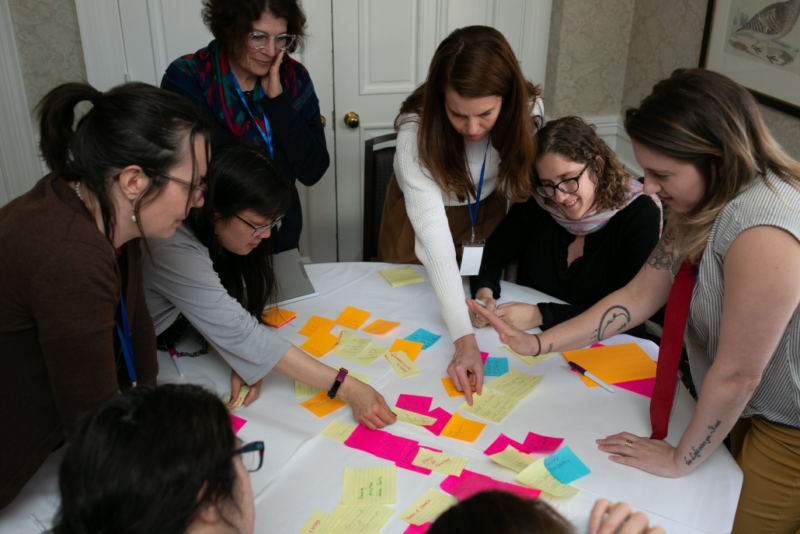Who Makes a Nation? Rethinking “A Nation of Immigrants”
11 March 2020 – Michelle Moon and Kathryn Lloyd
Authors’ Note: As you may be aware, NCPH annual meeting status has changed. We are planning to proceed with the group’s work, though we are not sure as to format as yet. We will talk with co-facilitators when we have a sense of the remote alternatives and be in communication with NCPH and prospective participants about the plan.
City on a Hill. Land of the Free. The Melting Pot. The Land of Opportunity. The United States has a way of taking on monikers—and some of these turns of phrase have real sticking power. This spring, one such phrase—“a nation of immigrants”—is a focus of investigation for a National Council on Public History (NCPH) Working Group at the annual meeting in Atlanta, Georgia.
The “nation of immigrants” nickname, in particular, is one we think a lot about at the Tenement Museum, where we interpret the lives of immigrants, migrants, and refugees who lived in two historic tenement buildings on New York’s Lower East Side. Many of our visitors call upon this phrase while reflecting on immigration as a force in their own lives, in their ancestry, or in the shaping of the United States. Often, they use it to reject anti-immigrant sentiments or to emphasize national pride. And the phrase also offers the comfort of cliché, a cozy rhetorical blanket wrapping Americans in the warmth of a welcoming national identity.
But as we work to make public history narratives more intentionally inclusive, the comfortable blanket isn’t wearing well; it’s threadbare and a little itchy. As we’ve tried to stretch “nation of immigrants” to cover the breadth of the stories we are telling—stories that include those of internal migrants, indigenous people, refugees, and people compelled to move through enslavement, violence, forced relocation, and segregation—the threads began to unravel completely. Since “immigration” generally connotes an intentional, voluntary migration across national borders to take up permanent residence, there was no way that considering all residents of the United States as just one kind of immigrant or another could do justice to the diversity of our stories.
We asked ourselves: where did this flattening notion come from, anyway? In her investigation of the phrase, “A Nation of Immigrants: Do Words Matter?,” historian Donna Gabaccia traces the phrase’s origin. In the nineteenth century, it flourished as a defensive trope, used by immigration restrictionists to establish bona fides as children of immigrants, in order to deflect critics accusing them of hostility to immigration itself. In the twentieth century, it was repurposed to argue for the legitimate Americanness of recent arrivals and to expand access to legal immigration. In 1958, Senator John F. Kennedy recruited it as the title for his book A Nation of Immigrants, published by the Anti-Defamation League, an advocacy organization opposing Anti-Semitism and other forms of discrimination. Amid the multiculturalist rhetoric of the 1990s, the phrase “nation of immigrants” called to mind a sepia-toned, PBS-style montage of late nineteenth- and early twentieth-century European immigration: flat caps and shawls, clusters of children and stacks of traveling trunks, and expressions of hope and determination. In 2018, the US Citizenship and Immigration Service updated its mission statement, removing a statement upholding “America’s promise as a nation of immigrants” and describing itself instead as concerned with “administering the nation’s lawful immigration system.”
The phrase has always been polemical. Even when it’s used to support inclusion, the phrase misdirects attention away from critiques of anti-immigrant practices and policies, excludes indigenous people and those who came here through enslavement or as asylees, and falsely positions the United States with respect to other nations. As Gabaccia points out, the U.S. is by no means a leader in being seen as a home to people born elsewhere; about a third of the world’s countries have a higher percentage of foreign-born residents. The phrase also suggests a false equivalency between immigration and the nation itself—a move that cuts out vast populations. American identity doesn’t neatly reduce down to having a family history that includes migration across national borders.

Recreated living room of the Saez Velez family, Tenement Museum. The Saez Velezes, migrants from Puerto Rico, moved to New York in the 1950s. Their story is featured on the Museum’s newest tour, Under One Roof. Photo credit: Tenement Museum.
At the Tenement Museum, we became acutely aware of this when, in 2017, we launched our newest tour, Under One Roof. Of the three families featured on that tour, only one meets the definition of “immigrant”: the Wong family, who came from China in the 1980s. The other two families represent other forms of migration: the Epsteins, who arrived as displaced persons, refugees from the genocide and destruction of World War II, and the Saez Velezes, who came to New York from Puerto Rico, already U.S. citizens, seeking work opportunities.
Around the same time, we also built Your Story, Our Story, a web-based story-collecting exhibit. This exhibit initially focused on family stories of migration, but many participants let us know that framing excluded them. Where did descendants of the African diaspora fit in? What about indigenous people whose histories long predate immigration? What about descendants of colonial settlers—can we really call what they were engaged in “immigration?” Based on this feedback and input, we opened up the contribution criteria to stories of “cultural identity and migration,” creating a more inclusive entry point. Finally, in 2019, we began to research and develop programs about African American and black residents on the Lower East Side, communities whose presence has until recently rarely been clearly remembered or memorialized here. Across these and other programs, our visitors, staff members, and program participants were raising the question: How does my family’s history fit Into to narratives of America and the growth of its population?

Reimagining Migration April 2019 Seminar, Mapping Human Migration: Setting the Educational Agenda. Photo credit: Lindsey Michelle Photography.
A “nation of immigrants” would no longer work. We needed new language to present personal stories as they weave into the evolving and complex American identity. But we found we needed more than just new words. We also needed to retire certain interpretive tropes (for example, positioning a family story with economic ups and downs in terms of “achieving the American Dream”) and find or invent entirely new ways of understanding how human movements work in American history. Knowing we must not be alone in facing this need for new approaches, we proposed an NCPH working group. Joining us in this effort are Adam Strom and Veronica Boix-Mansilla of Reimagining Migration, an organization that helps educational institutions build their capacity to understand migration as a “fundamental characteristic of the human condition, in order to develop the knowledge, empathy, and mindsets that sustain inclusive and welcoming communities.” Also helping to facilitate the group is Sara Phalen of the West Chicago City Museum, a local history institution expanding beyond traditional timelines that center European-American municipal founders, while leaving out the indigenous people who came before them and the diverse migrants who came after.

Visitors viewing the West Chicago City Museum’s exhibit “Creating Mexican American Identities: Multiple Voices, Shared Dreams.” Photo credit: West Chicago City Museum.
The new inquiries have sent us to digging into recent scholarship in migration studies. For some time, academic scholars have situated migration within larger histories of human movement, displacement, colonization, and diaspora. We’ve been looking at sociolinguist Otto Santa Ana’s scholarship on water metaphors as anti-immigrant rhetoric; speaking with geographer Harald Bauder, who conceptualizes an “immigrant-Aboriginal parallax gap” between indigenous history and rights and immigration narratives; and Reimagining Migration’s Learning Arc, which reframes migration as a natural, ancient and continuous process.
These emerging academic perspectives have only just begun to permeate public history. Our working group is eager to absorb new understandings and integrate them into an open-access resource toolkit that can support refreshed public-facing narratives of immigration and other processes of population development for you and your work, presenting the development of national identities and narratives in a more inclusive way that is accessible for the public. We invite you to join our public working group session at the meeting in Atlanta, on Thursday, March 19, 10:30 a.m. – 12:30 p.m. Your ideas and insights will help build the toolkit we need. The work is daunting but exciting, and we hope just one early stage of deeper reimagining of what it can mean to belong, to welcome, and to comprise a nation.
~Michelle Moon is Chief Program Officer at the Tenement Museum, overseeing interpretive experiences that illuminate the experiences of the people who lived in two historic tenement buildings on New York’s Lower East Side. Formerly, she held positions in education and interpretation at art and history museums including the Peabody Essex Museum and Mystic Seaport. She is the author of Interpreting Food in Museums and Historic Sites.
~Kathryn Lloyd is the Director of Programs at the Tenement Museum, where she collaborates on museum programming and educator training to explore social issues through personal experiences, and to connect people to each other through interpretation of the past. Prior to joining the Tenement Museum, she taught in cultural institutions and schools in New York and Barcelona.



